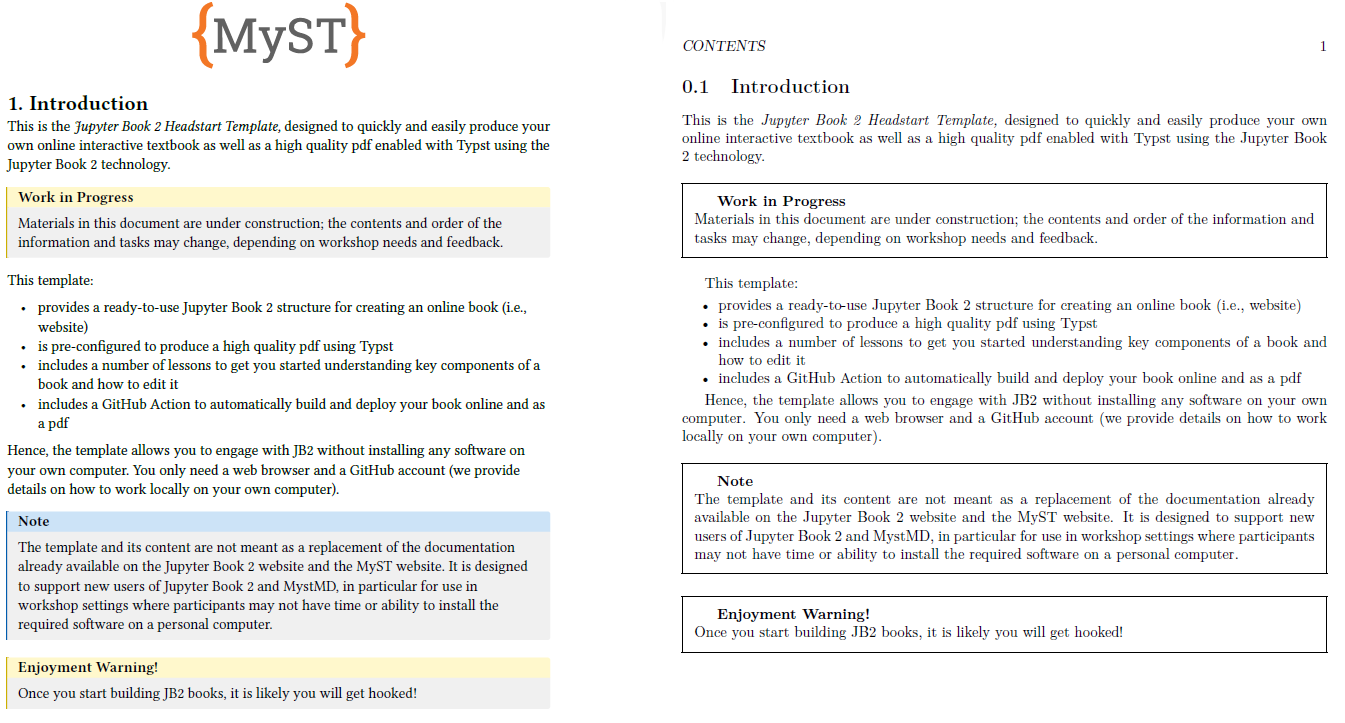Jupyter Book 2 currently supports two primary ways to export your book as a PDF: LaTeX or Typst. Both are powerful tools for generating high-quality PDFs, but they differ in several key aspects (additional advantages and disadvantages described here):
| Feature | Typst | LaTeX |
|---|---|---|
| Ease of Use | Modern syntax, easier to learn and use | Steeper learning curve, more complex syntax |
| Speed | Fast compilation | Slower compilation, especially for large docs |
| Customization | Templates are easy to modify | Highly customizable, but requires more effort |
| Integration | Designed for MyST Markdown and Jupyter Book | Widely supported in academic publishing |
| Community | Growing, newer ecosystem | Large, established community |
| Features | Good support for math, figures, and tables | Extensive support for math, figures, tables, and packages |
| Output Quality | High-quality, modern look | Professional, traditional academic look |
In short: choose Typst for simplicity and speed, or LaTeX for advanced customization and compatibility with academic standards.
Below we provide the screen shots of the PDF output using Typst (left) using the plain

Figure 1:Comparison of PDF output using Typst (left) and LaTeX (right) using both the plain book template.
You can specify the output template, download the template and tweak to match your preferences. We won’t go into detail here, but you can find more information in the MyST Markdown documentations.
Choosing Typst or LaTeX¶
When starting your own project, consider whether a PDF output is desired.
If so, consider the interactive elements that may be included and wether or not, some functionality and not all multimedia are supported in a PDF.
For instance, a *.gif file cannot be included in a PDF.
JB2 is thoughtful in this by choosing the best possible alternative if multiple files with the same name but different extensions are present: gif is chosen over png, png over jpg.
Rather than specifying the extension, you can just use the file name and an asterisk, e.g. .
For YouTube clips and online interactive materials embedded through iframes, you can make use of plugins. See for instance the iframe-to-thumbnail plugin. This plugin replaces the iframe with a thumbnail image that links to the original content as well as a QR code and a link in the caption.
Additional Considerations¶
WIP
Excluding and including sections for PDF[1]¶
If you need to inject some LaTeX or Typst-specific content into their respective exports, you may use the {raw:latex} or {raw:typst} role and directive. For example, to insert a new page in Typst with two columns:
Or,
+++ { "page-break": true } for a page break.
The content in these directives and roles will be included exactly as written in their respective exports, and will be ignored in all other contexts.
You may use block metadata to insert page breaks into your PDF or docx export with +++ { "page-break": true }.
This will have no impact on your MyST site build nor other static exports that disregard “pages” (e.g. JATS).
Typst¶
When exporting to Typst format, you can provide Typst-specific math content using the typst option. This allows you to use native Typst syntax instead of relying on tex-to-typst conversion, which may give incorrect results.
Example with typst argument in a math block:
https://
Directly copied from the official Myst documentation.